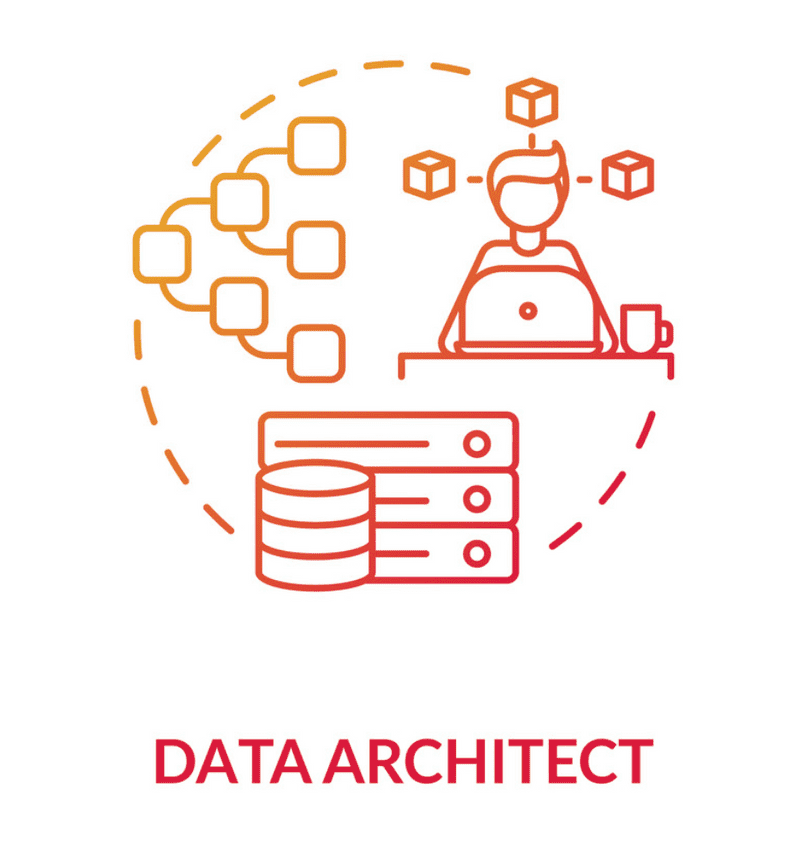How To Become a Data Architect in 5 Steps

In this article
The explosive increase in data-driven decision-making within the business world has made for a dramatic rise in job growth in nearly all fields pertaining to data analytics. Commonly considered opportunities are data analysts, data engineers, and data scientists, but one position often goes overlooked: data architect.
With positions as diverse as database administrator (with a median pay of $98,860 and job growth rate of 10%) or computer network architect (median pay of $116,760 and growth rate of 5%), the Bureau of Labor Statistics shows that the job of a data architect is both lucrative and expanding.
Considering that data architecture involves the design of the digital infrastructures that data professionals rely on, it should come as no surprise that this position is in such high demand. The only question, then, is not if you should pursue this career path, but how to become a data architect.
Interested in becoming a data architect? Springboard can help! Explore everything you need to know about becoming a data architect in this guide.
What Is a Data Architect?
Before you can know how to land this role, it’s important to understand what a data architect is.
Just as an architect working with physical systems creates designs for the construction of physical structures, data architects use digital systems to create digital structures. Whereas a data analyst crunches numbers to solve business problems and a data scientist poses the questions to be solved, a data architect creates the tools needed for other data professionals to succeed rather than using the tools themselves.
Practically, this involves using coding expertise (Java, Python, or SQL, for example) to create and implement technology architectures like data warehouses and data lakes so that other members of your organization may use them to find the business insights they need.
Some core competencies of a data architect are:
- Math
- Coding
- Systems analysis
- Analytical problem solving
- Data visualization
- Business skills
With these core data architect skills in place, you’re ready to begin your journey into data architecture.
What Does a Data Architect Do?

If you want to become a data architect, expect to do the following on a regular basis:
- Communicate with non-technical professionals to discern the data needs of your business.
- Examine your company’s current data infrastructure to see how it can be improved.
- Set up new data models that make for better analysis.
- Use your coding skills to implement new data architectures that improve upon your current databases while retaining information from the old.
- Maintain regulatory compliance with all your data reservoirs, avoiding costly penalties.
- Stay up to date on the most innovative data architectural techniques.
The responsibilities of a data architect are far-reaching, but they can mostly be tied to the fundamental duty of keeping a company’s data systems optimized.
Get To Know Other Data Science Students
Sam Fisher
Data Science Engineer at Stratyfy
Aaron Pujanandez
Dir. Of Data Science And Analytics at Deep Labs
Mikiko Bazeley
ML Engineer at MailChimp
How Much Do Data Architects Make?
According to ZipRecruiter, the average salary of a data architect is $132,617 per year, with salaries in the 25th to 75th percentile ranging from $110,000 to $152,500, respectively.
The range in data architect salaries is evidence of the potential for upward advancement in the industry, most of which comes as workers gain years of experience.
5 Steps To Become a Data Architect?
-
Get the right skill set
-
Get certified
-
Get experience
-
Get connected
-
Get polished
Because the job description of a data architect is so diverse and changes rapidly, the path toward becoming one is less established than for other data professionals. That said, there are a few essential steps to take:
- Get the right skill set. The vast majority of entry-level data architects hold a bachelor’s degree, typically in computer science, computer engineering, information technology, or another related field. To advance their career, many obtain a master’s degree as well—though other resources like online courses and bootcamps can equip you with the necessary skills.
- Get certified. There may not be many specific data architecture degrees out there, but there are a number of certification programs you can enroll in. Here are a few common certifications that data architects often pursue:
- Get experience. Although data architecture is a highly coveted field, it’s unlikely that degree holders will enter it without some prior experience. That’s why internships and data bootcamps in similar fields like data analytics and data science can be such an asset.
- Get connected. By establishing a professional network and honing your skills under the tutelage of a mentor, data engineer and data scientist you’ll gain deeper insights into the field and be better prepared for entering the data workforce.
- Get polished. Once you’ve obtained all the tools you need to enter data architecture, what remains is to groom your resume so that it shows you’re the right fit for the job. A few distinct features of a data architect’s resume may include continuing education in database management and network management, or certifications that prove your expertise with tools like Hadoop, Oracle, Linux, and ETL.
With so few degrees in data architecture relative to the high demand, it’s clear that the field of data architecture isn’t restricted to those with a specific tech background. If you have the core skills—or are willing to develop them—and you put forth the effort it takes to complete the journey, you may find an entrance into this valuable role.
Since you’re here…
Curious about a career in data science? Experiment with our free data science learning path, or join our Data Science Bootcamp, where you’ll only pay tuition after getting a job in the field. We’re confident because our courses work – check out our student success stories to get inspired.





